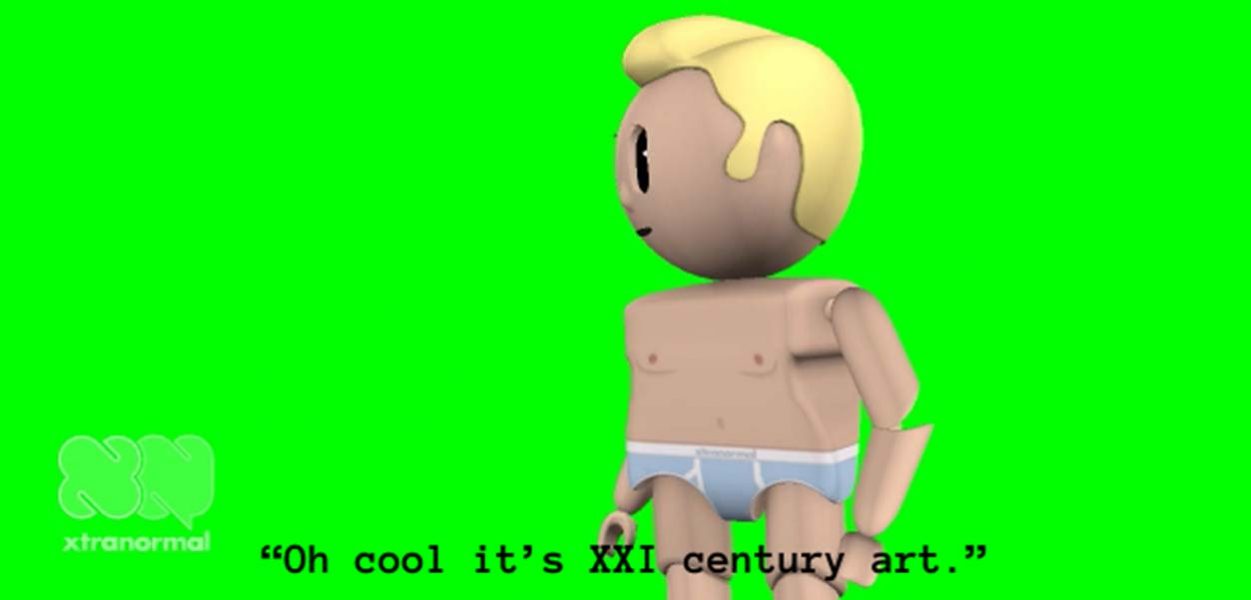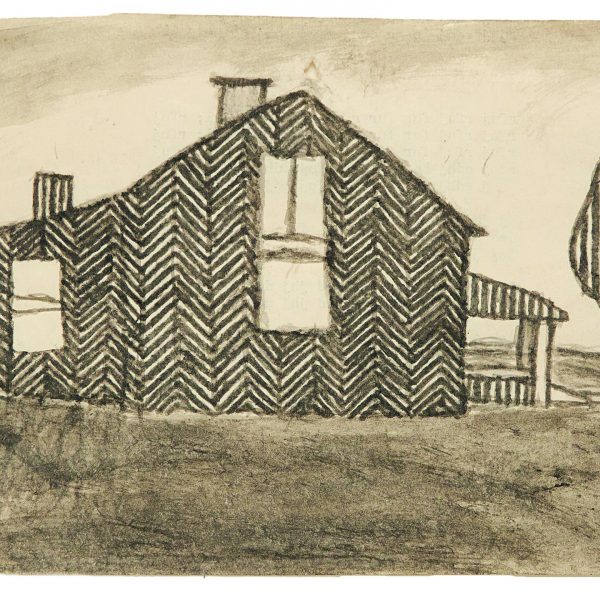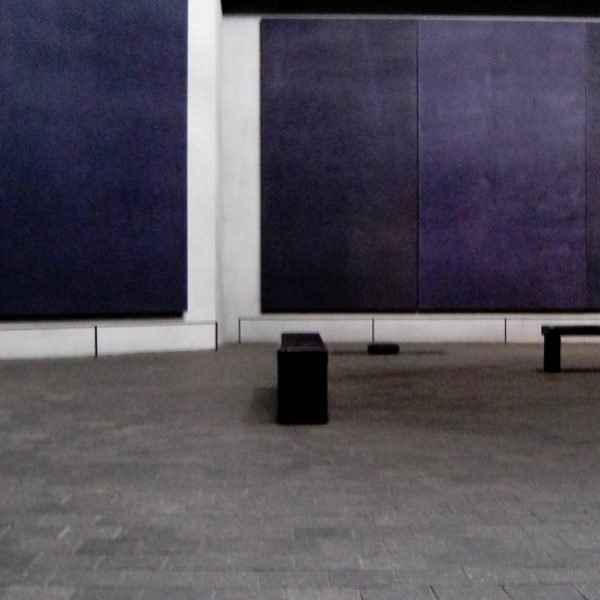In Your Digital Dreams: Art in the Age of the Internet
Interview with Jeffrey De Blois
By David Ebony
One of my first internet projects was to write a monthly column for a website called Art Icons, beginning in the early 1990s. An experimental site, short-lived, and now defunct, Art Icons was perhaps one of the first web venues devoted exclusively to contemporary art and artists. Covering gallery and museum exhibitions, the project’s aim was to chronicle the art scene in New York and around the country. At the suggestion of artist, writer, and my longtime Art in America colleague, Walter Robinson, I contributed to the site each month “David Ebony’s Top 10,” a roundup of contemporary art exhibitions that were currently on view in New York and environs. Each show was represented by a single image and a short review. In the mid-1990s, after Art Icons folded, Robinson commissioned me to resume the column at artnet News, where he had become the founding editor-in-chief of the site’s online magazine.
In the early days of the World Wide Web, the most challenging aspects of surfing the internet were technical and temporal. Simply logging on could be a tedious and horribly time-consuming chore, requiring a tremendous amount of patience. You could never be sure of a stable connection, and once online, the amount of time it would take to download a particular site was always daunting—uncertain and unpredictable. The images were especially languorous; it could take five minutes or more to download a picture. Since it was illustrated with ten pictures, one image per entry, my Art Icons “Top 10” column took forever to download.
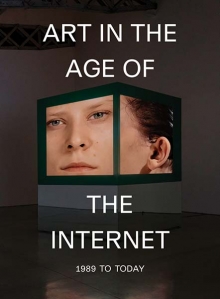 Certain artists I knew and admired at the time, especially video and electronic art pioneers Nam June Paik, and his wife, Shigeko Kubota, anticipated the realization of the internet, and to some degree paved the way toward its inception, and thus the birth of internet art. Paik had heralded a new era of telecommunications with his concept of the “Electronic Superhighway,” which he introduced in 1974. His work is central to the seminal 1993 book Art of the Electronic Age by Frank Popper. Paik’s achievement is also key to the most recent exploration of the subject, Art in the Age of the Internet: 1989 to Today, an expansive exhibition and fully illustrated accompanying book. The show debuted at the Institute of Contemporary Art / Boston [Feb. 7-May 20], with further venues and dates to be announced.
Certain artists I knew and admired at the time, especially video and electronic art pioneers Nam June Paik, and his wife, Shigeko Kubota, anticipated the realization of the internet, and to some degree paved the way toward its inception, and thus the birth of internet art. Paik had heralded a new era of telecommunications with his concept of the “Electronic Superhighway,” which he introduced in 1974. His work is central to the seminal 1993 book Art of the Electronic Age by Frank Popper. Paik’s achievement is also key to the most recent exploration of the subject, Art in the Age of the Internet: 1989 to Today, an expansive exhibition and fully illustrated accompanying book. The show debuted at the Institute of Contemporary Art / Boston [Feb. 7-May 20], with further venues and dates to be announced.
Organized by Eva Respini, the museum’s chief curator, with Jeffrey De Blois, assistant curator, the exhibition contains classic artworks from the 1990s by Paik, Dara Birnbaum, Judith Barry, Gretchen Bender, Jon Kessler, and others. Also featured are of-the-moment pieces by Cory Arcangel, Anicka Yi, Josh Kline, Antoine Catala, Paul Pfeiffer, Pamela Rosenkranz, DIS, Juliana Huxtable, and many other contemporary luminaries. Respini is the principal author of the book, which also contains essays by curators Kim Conaty, Tim Griffin, and Thomas J. Lax, among others. In the book, De Blois outlines the exhibition’s thematic structure and succinctly describes its ambitious directives.
In the short span of barely twenty-five years, the internet has become, for many of us, part of our everyday lives, central, in fact, to our daily routines. In her introductory essay, “No Ghost Just a Shell,” Respini describes the tumultuous developments that have led to this global phenomenon, and the corresponding advent of internet art. In the process, she cautions about assumptions of the internet’s supposed universality. “As it turns out,” she states on page 14, “the internet is neither universal nor omnipresent, considering only 40 percent of the world’s population is able to access an internet connection.” In a recent telephone conversation, De Blois shared with me his thoughts about the conundrums of the “Internet Age,” and the scope of this provocative exhibition and publication, which aims to illuminate some of the controversial issues surrounding this cultural touchstone.
David Ebony Art in the Age of the Internet is a fantastic book, but for those of us who didn’t see the related exhibition, could you provide an overview of the show, and an idea of the installation?
Jeffrey De Blois Art in the Age of the Internet 1989 to Today looks at the effects of the internet on artistic practice. It explores the ways that artists make their work, the ways that it is circulated, and how that circulation actually becomes a structuring principle for the work. The exhibition contains seventy-two art works by sixty artists, an international and multigenerational group. It’s thematically organized, not chronological.
Ebony Are the works in the exhibition arranged in the way that you have them organized in the book: “Networks and Circulation,” “Hybrid Bodies,” “Virtual Worlds,” and so on?
De Blois Yes. Each of them was a kind of stand-alone gallery, with an organizing theme that allowed us to have some productive juxtaposition of works by artists from different places and of different generations working with a similar set of concerns.
Ebony What were the greatest challenges in putting this show together?
De Blois Some of the challenges were related to the different technologies that we presented in the galleries, so everything from computers that we had to source from the mid-1990s, to classic Sony CRT monitors to the most up-to-date Oculus Rift goggles for a virtual reality piece we commissioned from Jon Rafman [View of Harbor, 2017]. So a big challenge was to manage all of those things, the various technologies and their idiosyncrasies. Another was the scope of the exhibition, working with many of the artists in close dialogue to imagine the presentation of their works within the context of the exhibition. It took a lot of time and research; it was about a three-year process.
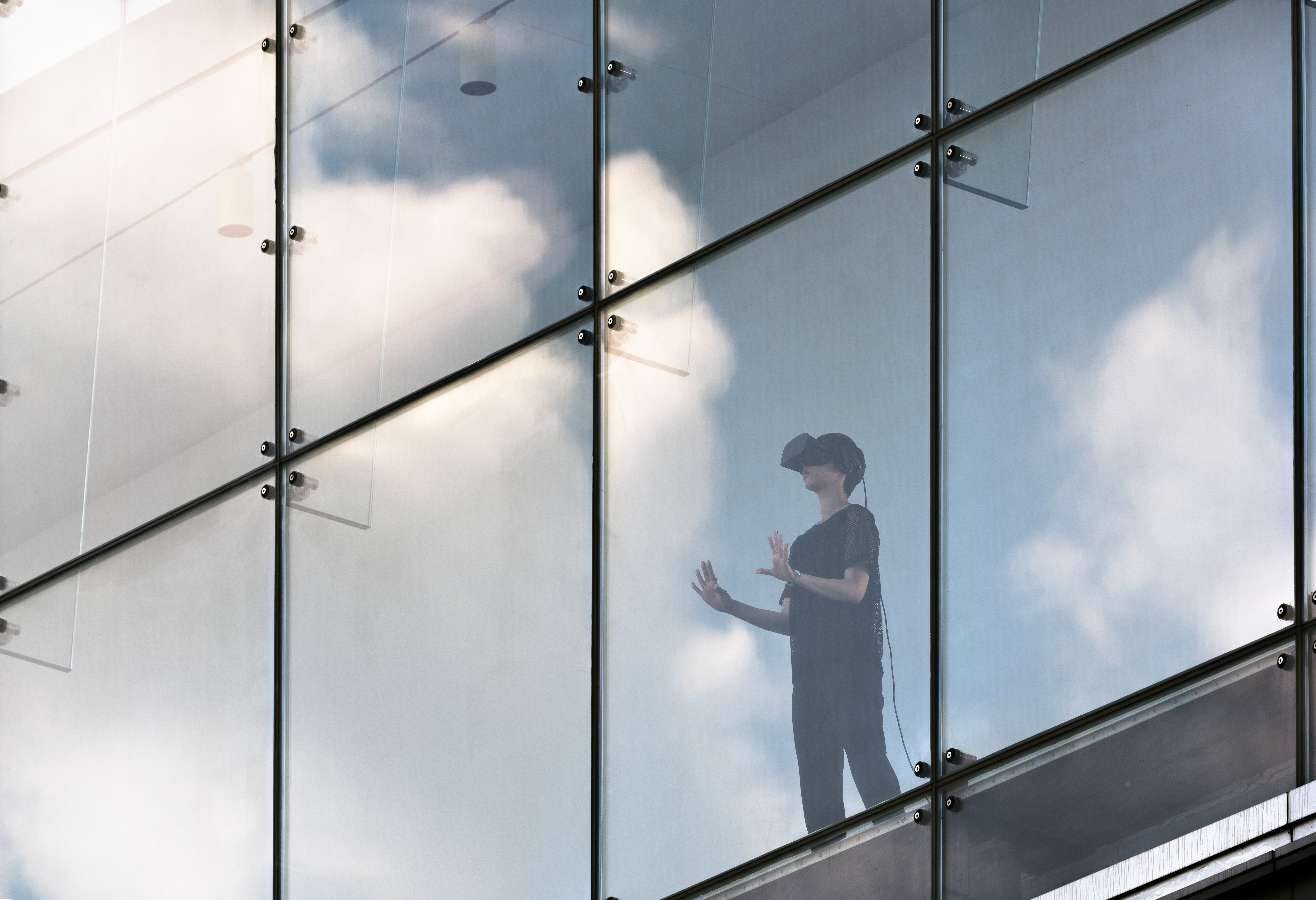
Jon Rafman, View of Harbor, 2017. Virtual reality headsets and 3-D simulation (color, sound; approximately 8:00 minutes). Courtesy the artist. Photo by Matthew Monteith. © Jon Rafman
Ebony You start out with “Networks and Circulation.” Can you say something about that? It’s certainly something that we have to deal with today as we become increasingly inundated with data.
De Blois Being inundated with data, yes, and images in particular, in both public and private spaces. And then there is the accessibility of cameras today. Most people walk around with a pretty sophisticated camera in their pocket, and there tend to be cameras everywhere, capturing and circulating images at an increased velocity that we’ve never seen before. In this thematic section, we wanted to consider the various ways artists have considered the circulation of images within a kind of global communications network. The section encompasses a range of issues, including, for example, rethinking appropriation in an age of 3-D printing technologies. The ability to make exact copies of extant art works in a museum, for instance, and how one can create an exact duplicate of a sculpture, brings up questions of authorship that have long been part of the dialogue of contemporary art.
There is also the idea of making physical the experience of being on the internet, considering works by Camille Henrot, and Hito Steyerl, among others, wherein the everyday structure of using the computer, as with the overlapping windows we have open simultaneously, and the ability to process all of this information, changes our bodies and our relationship to ourselves in a particular way. Each work in this section looks at and beyond aesthetics to tell us something about our everyday relationship to internet culture.
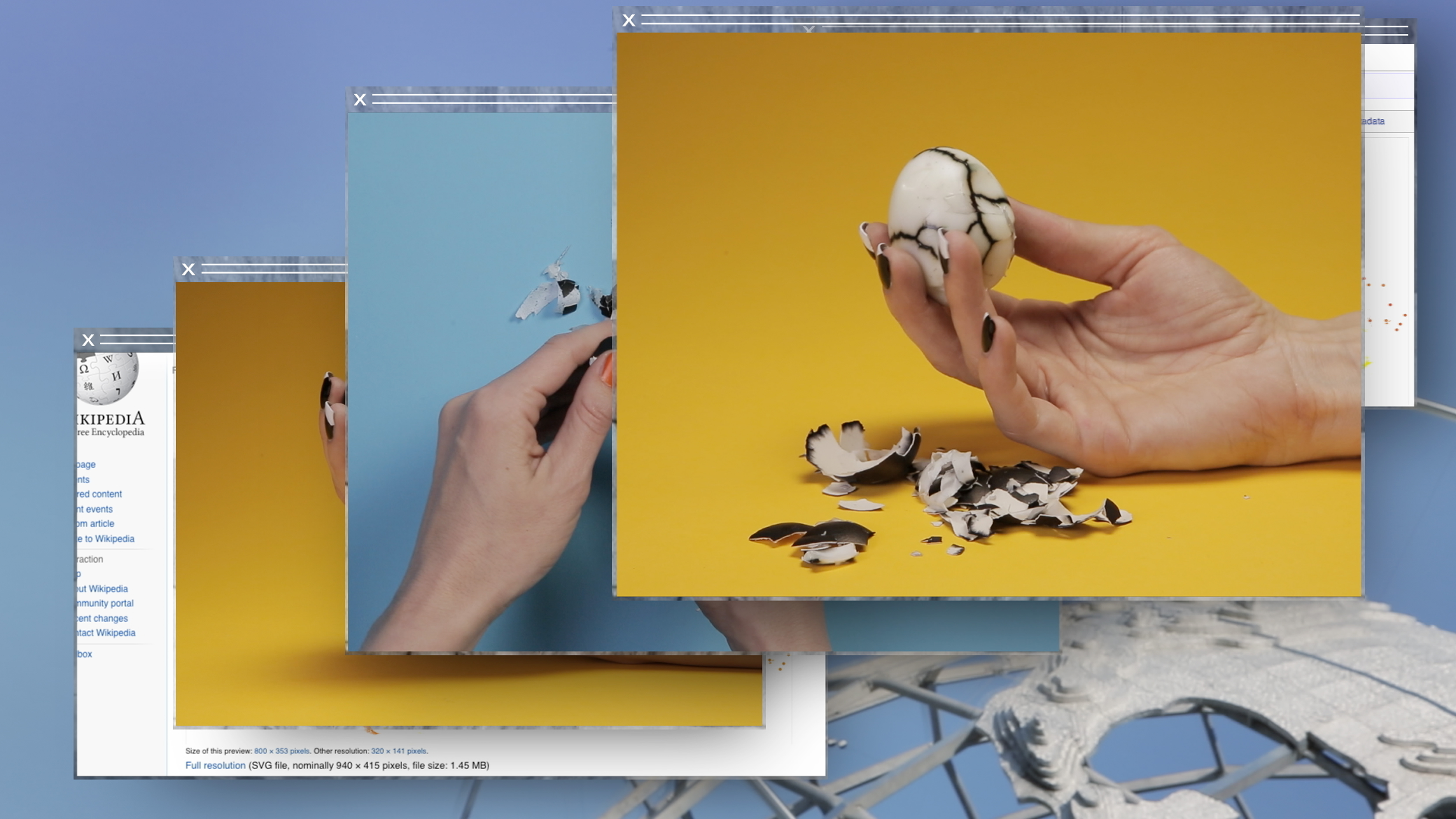
Camille Henrot, Grosse Fatigue (still), 2013. Video (color, sound; 13:00 minutes). Courtesy the artist, Silex Films, and kamel mennour, Paris/London. © 2016 ADAGP Camille Henrot
Ebony You bring up a rather ominous point in this section that the internet is getting increasingly corporatized. Can you explain how and why this is happening?
De Blois I think that to a certain extent we all have access to internet today because it was initiated in the early 1990s when there was a kind of utopian impulse about the democratization of the web. There was this idea that the internet would provide a platform or a public space for the free expression of the democratic principals that presumably undergird it. The advent of commercial or corporate interests tends to homogenize culture. There is a kind of paradox there. I find that in my own experience, despite the great breadth of choices of what is available online, the kind of tyranny of choice means that I go regularly to only ten or so websites. I find that the increased corporatization tends just to reinforce other societal structures at large.
Ebony In another section, you explore the notion of “hybrid bodies.” What does that mean?
De Blois It’s a section that deals with the very basic question of what it means to be human in a technologically mediated society. For us, that entails looking at questions of labor, race, gender relations, and how some of these conventions are either opened up, or most often reinforced, by new technologies. There are works that look at the ideological underpinnings of, for example, software products that are made to render digital avatars of bodies. There is a work by Sondra Perry in which she creates a replica of herself, a digital avatar of her body using the default settings of a software program that she reveals to be skewed toward an idealized white body, and can’t accommodate her particular body type or skin tone.
A work by Kate Cooper looks at digital avatars employed in corporate advertising. It shows how women in particular are exposed to these kinds of images that again hinge on a white idealized notion of beauty that is unachievable for almost everyone. It explores the effect that these images have on women and their relationships with their own bodies. In essence, there is a kind of psychological violence inherent in these images; they seem hyper real, yet have very little basis in the real world.
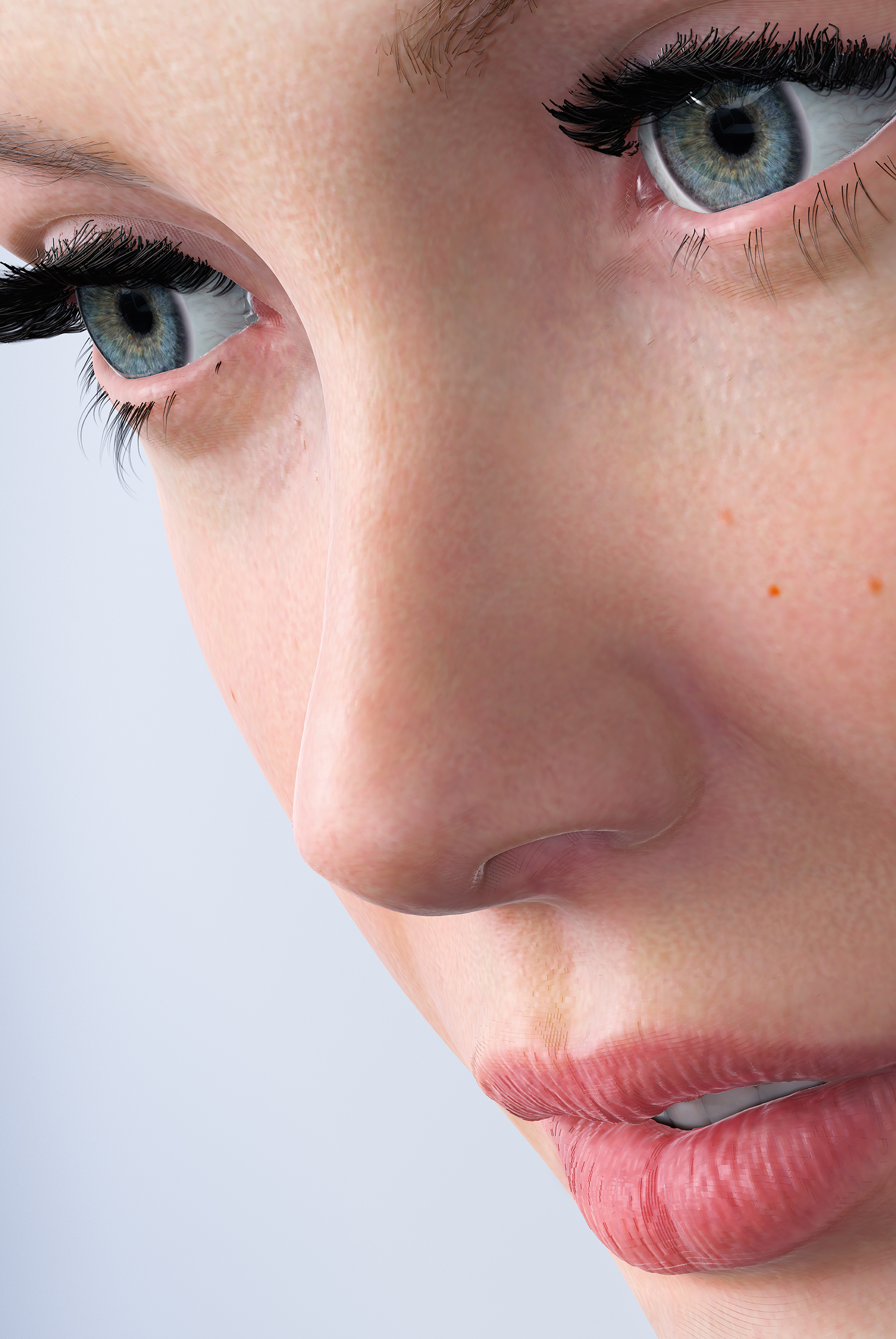
Kate Cooper, Rigged (still), 2014–15. Installation with digital prints and HD videos (color,sound; 4:28 minutes). Courtesy the artist. © Kate Cooper
Ebony “States of Surveillance” is a topic that, of course, has ever-increasing significance. What can you say about it terms of very early internet works in your show, such as Rafael Lozano-Hemmer’s Surface Tension (1992), which, as you mention in your text, was created in response to the “smart bombs” that were introduced in the first Gulf War in 1990-91?
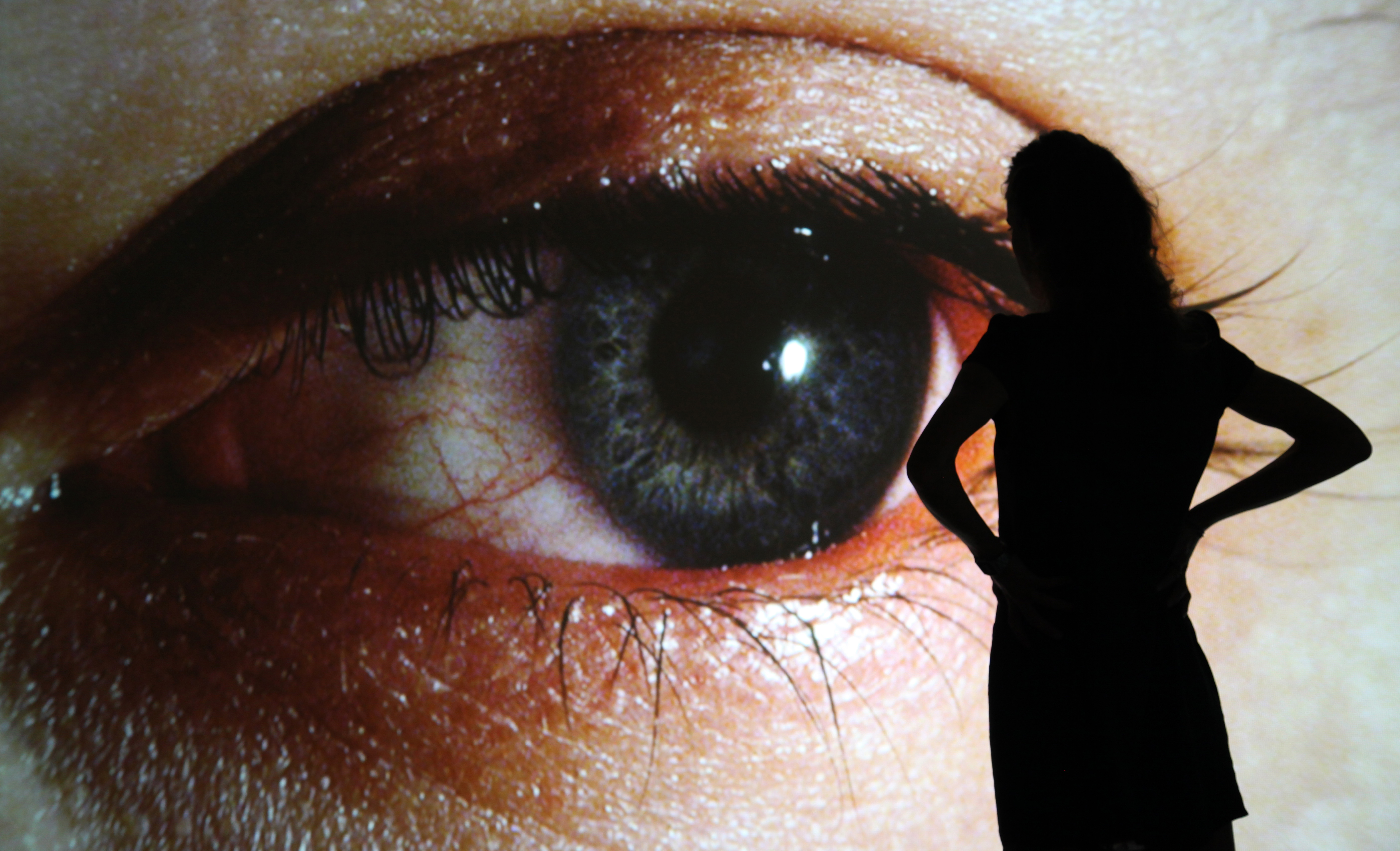
Rafael Lozano-Hemmer, Surface Tension, 1992. Installation view, Rafael Lozano-Hemmer: Trackers, La Gaîté Lyrique, Paris, France, 2011. Courtesy the artist and bitforms Gallery, New York. Photo by Maxime Dufour. © Rafael Lozano-Hemmer
De Blois We wanted to take a look at surveillance in a number of different ways. One way was to look at the global scale of mass U.S. surveillance, symbolized by the NSA data leaks that Edward Snowden made in 2013; but then we also wanted to look at domestic forms of surveillance that have new urgency in the digital age. Works by Julia Scher and Lynn Hershman Leeson come to mind in that respect. But we also considered forms of domestic surveillance in places like China and certain countries in the Middle East, where surveillance is state controlled. Censorship of the web comes into play here to a certain degree. There’s a great piece by Chinese artist and activist aaajiao titled Gfwlist [2010] that looks at the so-called “Great Firewall of China.” It is a kind of monolith embedded with a thermal printer that prints out a list of websites banned in China in code, suggesting that encryption is a means of subverting some state-sanctioned surveillance regimes.
Ebony How did the audience react to these installations? Were there certain pieces that visitors gravitated toward more than others?
De Blois The responses were really varied, and positive. Two works by Lynn Hershman Leeson in the “States of Surveillance” section drew a great deal of attention. She made two cybernetic dolls that have cameras for eyes, and they broadcast the galleries to a website that people could go to and then manipulate the dolls, move their heads to scan the gallery, etc. Part of the work is a small screen where viewers could see themselves through the dolls’ eyes. Works like these—in which the viewer’s own image is part of the artwork—asked them to open up their thinking about surveillance. And it was something they responded to very strongly—either they were freaked out by it, or they had a nuanced experience seeing their own image through the doll’s eyes.
Ebony What do you hope viewers and readers will come away with from this exhibition and the book?
De Blois My basic hope is that people will come away asking questions. It’s the explicit aim of so many technologists and new technologies to become intertwined in our everyday lives in such a way that we forget to ask questions about them. That is not to say that these technologies shouldn’t be part of our daily lives. What I have seen in so many of these great works by the artists here, produced over the past thirty years or so, is that they offer a moment of pause for us to consider the technologies. These works allow us to ask the important critical questions about them because technology isn’t neutral. It is designed and produced by human beings, so it has the same fallibilities that humans have. I hope it leads at least some people to an increased awareness of technology, and the relationship of technology to everyday life, even as it seems to be intensifying.
Jeffrey De Blois is Assistant Curator at the Institute of Contemporary Art / Boston. He previously served as curatorial fellow at MIT List Visual Arts Center.
David Ebony is currently a Contributing Editor of Art in America magazine. Among his books are Beatriz Milhazes (2018), Arne Svenson: The Neighbors (2015); Anselm Reyle: Mystic Silver (2012); Carlo Maria Mariani in the 21st Century (2011); Emily Mason (2006); Botero: Abu Ghraib (2006); Craigie Horsfield: Relation (2005); and Graham Sutherland: A Retrospective (1998). He lives and works in New York City.
Further reading:























